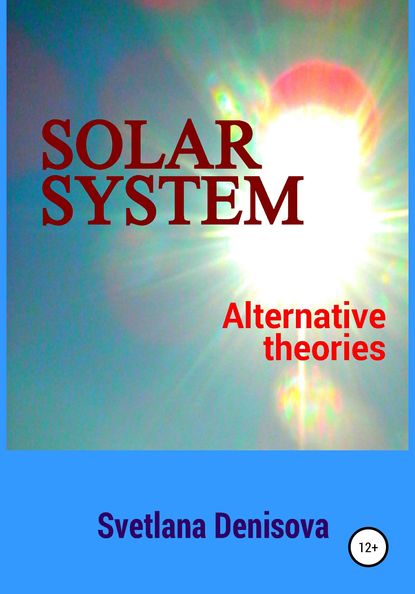 Полная версия
Полная версияSolar system / Alternative theories
Destruction of a solid crust of planets became the reason of increase in their volume and reduction of density. If we assume, that before destruction their density was equal to the Earth’s density 5515 kg/m3, it is possible to estimate their volumes before destruction, having divided mass on 5515 kg/m3. The calculation results are shown in Table 3.

Using the calculated volume (l.1 tab.3), it is possible to calculate the radius of planets before destruction (l.2 tab.3) by a formula: R3=3V/4π. Table 3 shows, that Saturn has the greatest coefficient of increase 2.07, and the Neptune has the smallest coefficient of increase 1.48 (l.3, tab.3). The Uranus before destruction was smaller in volume, than Neptune and after the destruction became larger than it. On the basis of the calculated data, received in table 3, it is possible to present an evident expansion of planets after destruction.
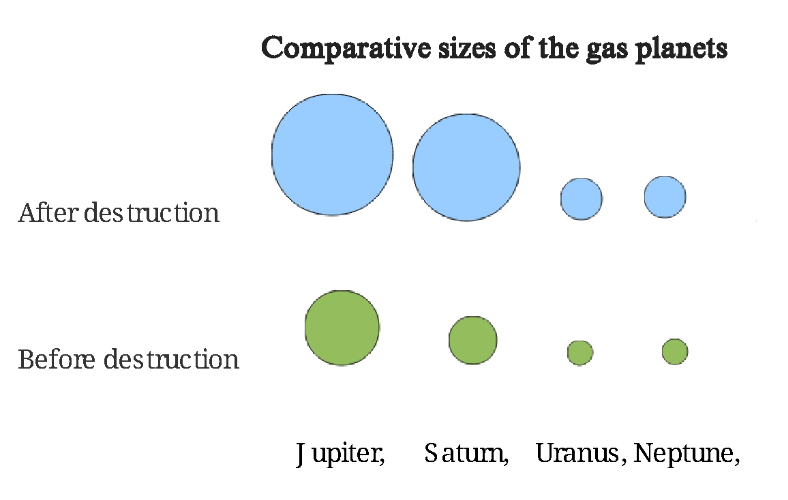
The picture shows a significant increase in the size of gas giants after the catastrophe. After destruction of planets, the speed of axial rotation has considerably increased, on average up to 10 hours/day, except the Neptune – the 16 hours/day. Increase in the equatorial diameter is a result of high-speed axial rotation of these planets. Some dwarf planets have similar characteristics, for example, Houmea. Perhaps, their crust has been destroyed too.
The waters of the oceans poured down into the cracks, and the fire burst forth out of the cracks toward the waters. The two confronting elements, water and a fire, have merged in the last dying battle. As a result of exposure to the high temperatures and, probably, nuclear reaction the chemical compounds disintegrated. Hydrogen (H) and helium (He) filled atmosphere:
Jupiter Н-89.8%, Не-10.2%, p-1.326 g/cm3;
Saturn Н-96%, Не-3%, р-0.687 g/cm3;
Uranus Н-83%, Не-15%, р-1.27 g/cm3;
Neptune Н-80%, Не-19%, р-1.638 g/cm3.
To understand the cause of the destruction of the planets, the Table 4 "Satellites of planets" was formed. The data for the table was taken from the encyclopedia Wikipedia. It is often changing, so the values in Table 4 may not reflect the latest changes. This table does not make analysis of the remote satellites of gas planets. They are grouped according to the proximity principle and orbits similarity. Each group is given the name of the largest satellite in it. Destroyed satellites highlighted in blue color, the moons (the spherical satellites) – in pink color.
Table 4. Satellites of the planets of the Solar System
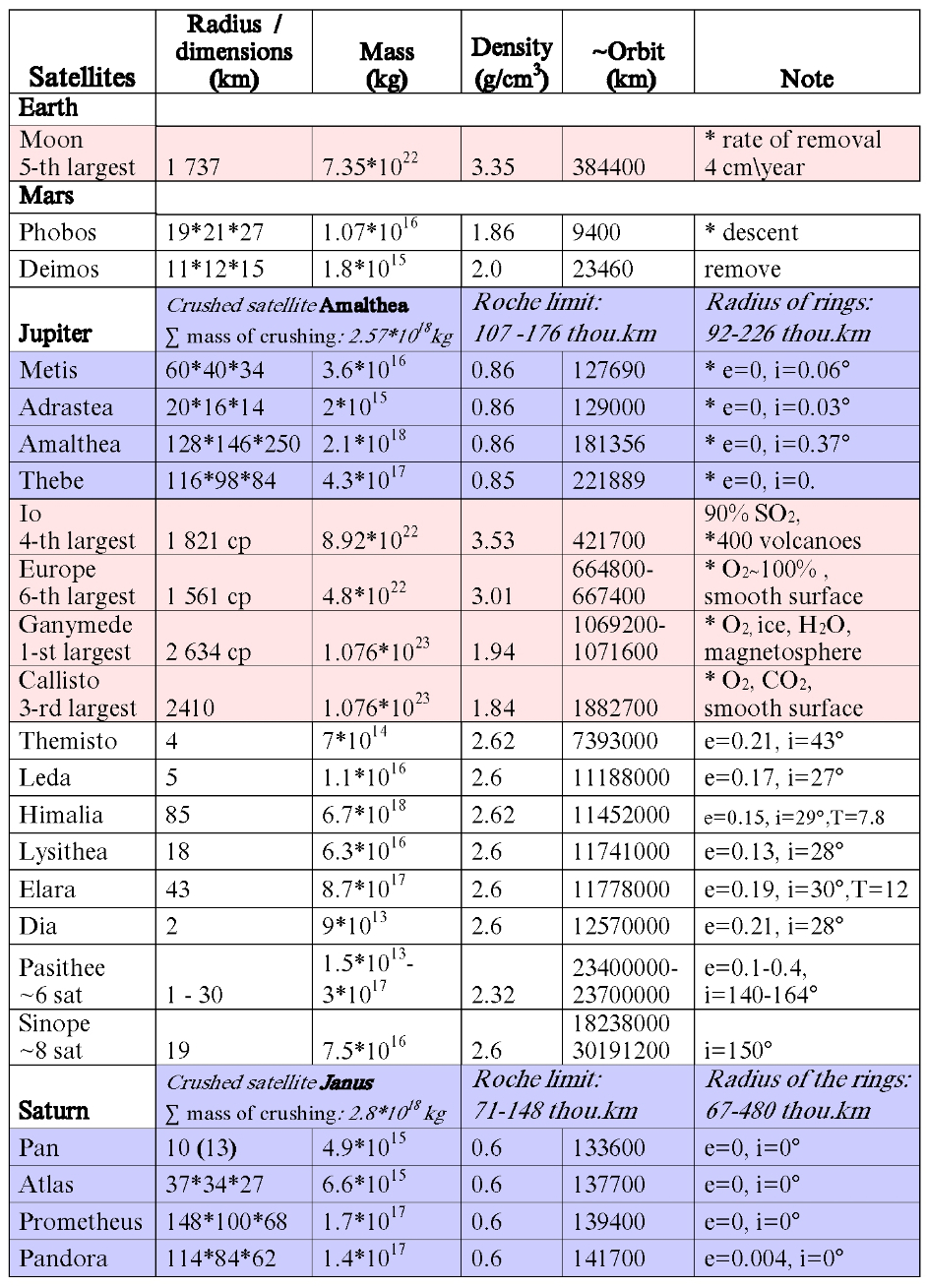
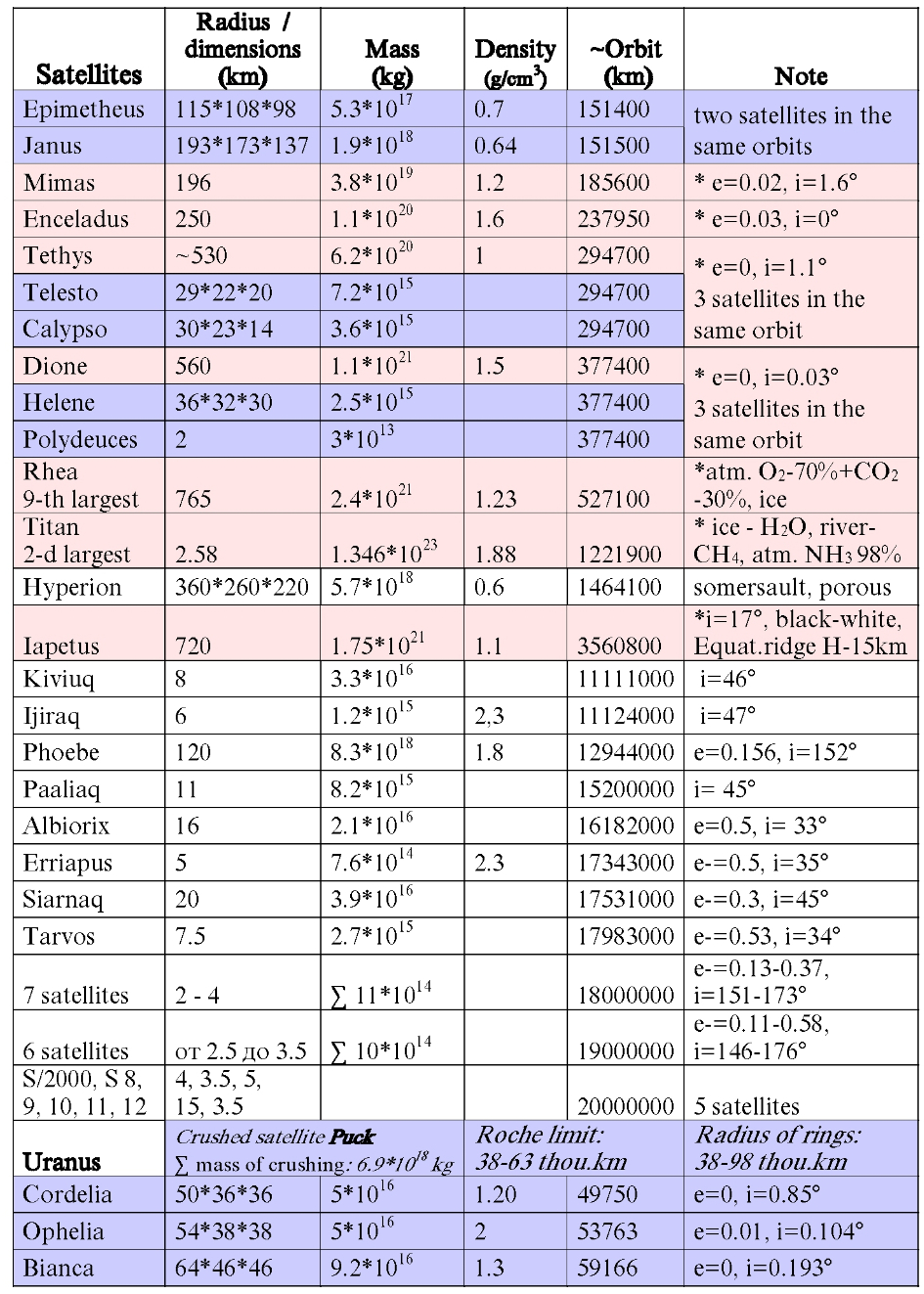
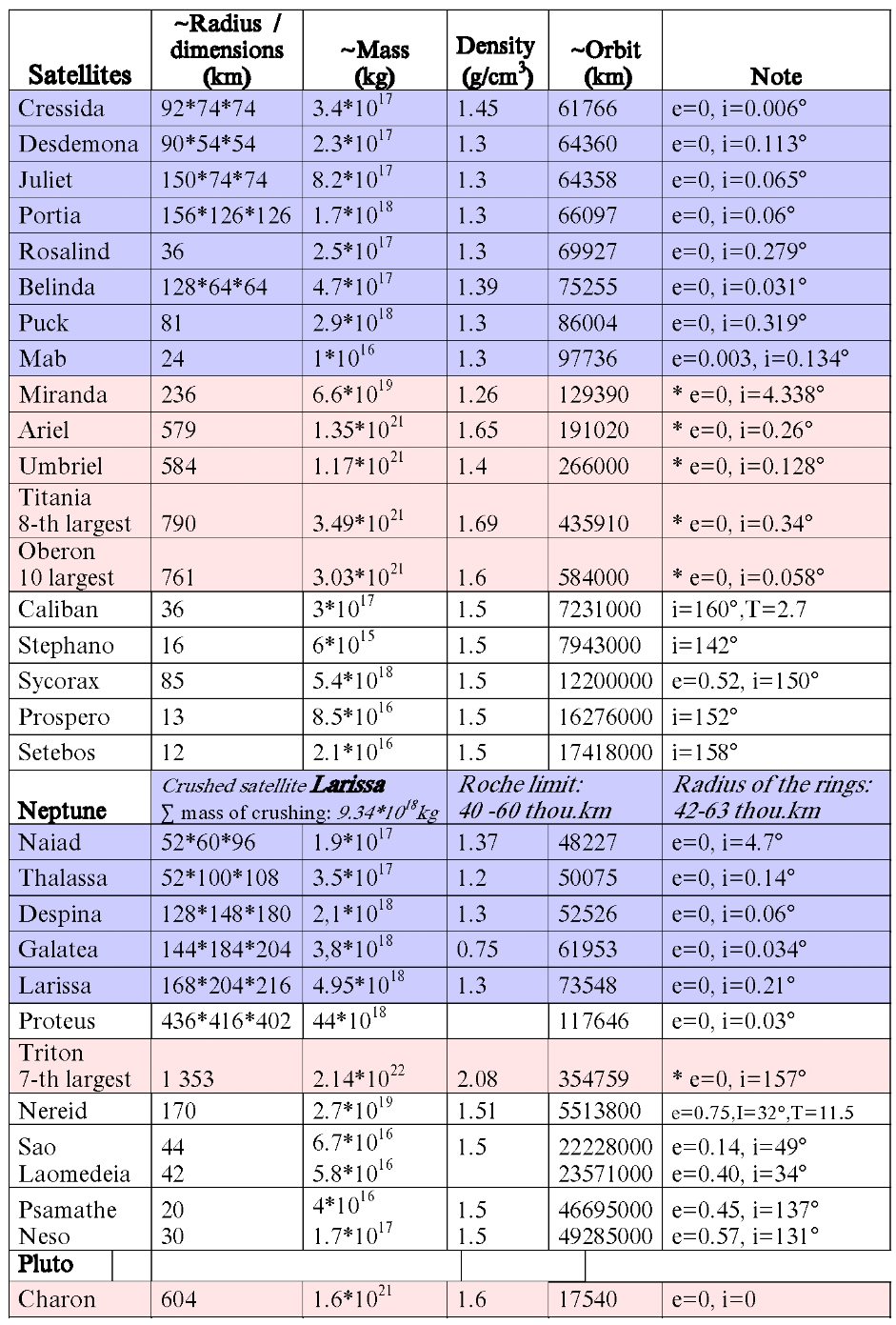
* Synchronized – always turned to the planet by the one side
Pink color – planetary satellites (moons)
Blue color – fragments of the destroyed space object
AB – asteroid belt
e – eccentricity
i – inclination of the orbit
Roche limit calculated by the simplified formula: R1* 2.46 – R2 * 2.46, where R1 – planet radius before destruction, R2 – after destruction (Table 3).
As it can be seen from Table 4, all the fragments of destroyed satellites are in zone of rings, on orbits nearest to planet, in Roche limit (blue color). All gas giants, behind a zone of destruction, have moons (pink color), and then the others satellites. Probably, the destroyed satellites were also the moons.
Consequently, the nearest moons, having the descending orbits, have reached the Roche limit and were crushed by the force of gravity.
Probably, it was a powerful explosion. The moon's core and magma fell on the planet, destroying its crust. They made up a large part of the moon mass. The volume of the planet has increased very rapidly. A core was not destroyed and preserved a spherical shape of a planet. The fragments of the satellite's crust have scattered to the nearby orbits. Small fragments, dust, sand and ice have formed rings. The most powerful explosion near Saturn has formed rings of 480 thousand km wide. The weakest explosion near Neptune has formed rings of only 63 thousand km wide. Large fragments in zone of rings attracted to itself particles and, as a result, the gaps emerged in the rings.
Jupiter has 4 large fragments of the shattered crust in the zone of the rings (92-226 thousand km): Metis, Adrastea, Amalthea and Thebe. The destroyed satellite can be called Amalthea, as it is the largest fragment. They have a total mass ~2.6*1018kg. It is only the part of the destroyed celestial body. A significant part of the mass is in the rings, which are dispersing in the course of time, falling to the planet and to the satellites in the zone of rings. Another part of the moon's mass, in the form of core and magma, probably, fell on the planet. In comparison with the other three destroyed planets, Amalthea has the minimum weight and the minimum number of fragments. It can be assumed, that the destructed satellite was small, but it was sufficient to destroy the crust of a giant Jupiter.
Saturn has the most powerful and the widest rings of 67-460 thousand km, visible in telescopes. Ten fragments of the destroyed satellite are in the zone of the rings. Their total mass is ~2.8*1018kg. The destroyed satellite can be called Janus by the name of the largest fragment. Neptune and Uranus have more fragments. However, the largest moon was crushed near Saturn. To confirm this, the following arguments can be cited:
– a large part of the mass is in huge rings;
– Saturn's destruction is the greatest of all four gas giant (the lowest density, the greatest amount of hydrogen);
– 4 whole moons in a zone of rings gathered a part of a mass (particles) from the rings;
– Lapetus has a powerful equatorial ridge, which, perhaps, has been gathered in the zone of the rings.
Apart from the fragmentary satellites, 4 moons: Mimas, Enceladus, Tethys, and Dione there are in the rings of Saturn.
Mimas is the smallest moon in the SS. It is interesting, that the destruction of Janus destroyed the shell of Saturn, but it did not destroy the moons in higher orbits. Among all intact moons, Mimas has the nearest orbit to the planet. Apparently, at the time of the explosion Janus, Mimas was subjected to a powerful bombardment. It has a lot of impact craters. lapetus is the most unique moon. It has 3 characteristic features: a giant equatorial ridge, a black leading side and a white back side, and the highest orbit among the moons.
Uranus has rings closest to the planet, located at the distance 38-98 thousand km. This can be explained by the fact, that before destruction Uranus was less, than the other three planets. Consequently, Roche limit is nearest to him. It has 11 fragments of the destroyed satellite, more than the other three gas giants. The destroyed object can be called Puck , by the name of the largest fragment. The total mass of the fragments is ~6.9*1018 kg, the second after Neptune. The rings of Uranus are insignificant in comparison with Saturn. This means, that the explosion was not strong. Probably, Puck was very old, and a little magma there was inside, and the crust was very thick. The more powerful explosion gives more small particles (rings). Presumably, numerous fragments have gathered particles from rings, or they were scattered. From all other SS planets Uranus is distinguished by the fact, that it "turned on its side" with its entire system of satellites.
Neptune has a faint system of rings 42-63 thousand km. It has 5 fragments of the destroyed satellite, with total mass ~9.3*1018kg. It is a largest mass from the all crushed satellites. It can be called Larissa, by the name of the largest fragment. Despite the largest mass of fragments, Neptune has minimum destruction among four gas planets?! It has the highest density and the slowest rotation – 16 hours/day, other gas planets – 10 hours/day. To explain this, we can assume, that the destroyed satellite was not moon (not of planetary type), or its crust was thick and internal magma was little, and the explosion was weak. The mission "Voyager 2" studied satellites of Neptune in 1989. Proteus – a large non-spherical satellite has an equatorial ridge, possibly, assembled from rings. Judging by Proteus, the rings were more wide and reached its orbit. Neptune has only 1 moon – Triton. It is the most remote satellite having eruptions.
The Asteroid belt is the destroyed planet Phaeton, between the orbits of Mars and Jupiter. Perhaps, here the biggest catastrophe in the SS occurred. The planet was shattered into pieces, forming a belt of fragments of various shapes and sizes and a segmented ring of sand and dust. The moon Ceres and several other satellites of non-lunar type remained intact on Phaeton’s orbit. The largest objects of the belt of asteroids are: Vesta, Pallada, Gigeya. Now there is a generally accepted view, that the Asteroid Belt could not have been a destroyed planet. As an argument, a small total mass of fragments is given. However, not all fragments are detected, but, probably, only the largest ones. There is much more of smaller fragments, but they are harder to find and measure. Has anybody taken into account their mass, the mass of the segmented ring as well as the mass of fragments ejected from orbit? Most likely, the mass of this planet was comparable to the mass of Mars. Another argument against the theory of planet destruction is the presence in the Belt of objects, which judging by their properties can not belong to one satellite. There are 2 explanations for this: either the Phaeton has collided with another space body and both have shattered, or this planet, apart from Ceres, had other satellites of a non-planetary type.
Varuna and Haumea are dwarf planets of the Kuiper belt (see Table 5). They have a very elongated ellipsoidal shape and very fast axial rotation – 3-4 hours/day. From this one can make an assumption, that their crust was destroyed, and they are gas planets.
Perhaps, there was also a small planet in the SS – the first from the Sun. This hypothetical planet can be called Lara. She was wife of Mercury in ancient Greek mythology. If this assumption is true, then it was completely destroyed. A belt of fragments and dust can be on the orbit of 30-36 million km. Probably, it is difficult to detect it in such proximity to the star, in its dazzling light.
It is possible to assume, that Earth was on the verge of destruction too. Most likely, it was when the continent Gondwana broke up and Atlantic Ocean was formed. Indians have a legend: once, a fire has erupted from the Earth. Earth stopped, turned over twice, and then began to spin as mad. Apparently, a very rapid rotation in that time saved its solid crust from complete destruction.
All these global catastrophes and destruction can not occur simultaneously. This requires a long period of time; therefore, the SS is very-very old.
4. Appearance of sunspots
There are different hypotheses about the origin of sunspots. Nowadays the most common accepted hypothesis best reflected in the electronic encyclopedia Wikipedia [7]. Here the appearance of sunspots is explained as perturbation of some sections of magnetic field of the Sun.
Here the appearance of the sunspots is explained by falling of different space bodies to the Sun’s surface. From this point of view, the magnetic field perturbation is not a reason for the appearance of sunspots, but on the contrary, is a consequence.
It has long been known, that the meteorites and other celestial bodies often fall on planets and satellites. The Earth and other planets are well protected from such "bombings" by atmosphere, in which the majority of small falling objects burn down. The moons without atmosphere have a lot of impact craters. For example, Mimas, moon of Saturn, is almost completely covered with craters from tiny to the giant ones.
The Sun is not an exception, on the contrary, because of its giant attraction, it is more often exposed to such falls. But unlike the moons, where an every falling forms a crater forever, the fire on the Sun surface deletes all traces of the falls over time. Not all falling objects can form sunspots. Most of them, having a small size or consisting mainly of ice, or loose rocks, burn up before reaching the Sun surface. Only the largest of falling objects leave a temporary spot.
Almost all the features of sunspots can be explained by the fall of the celestial bodies.
1. "They (sunspots) are regions of reduced temperature…" [Wikipedia]
The absence of fire makes these areas relatively less hot, than the rest of the Sun surface. The temperature of falling objects is much below the Sun surface temperature. When approaching the Sun, they are warming up quickly, and their surface begins to burn.
2. "Most solar flares and coronal mass ejections originate in magnetically active regions around visible sunspots groupings."
There is a photo, on which one can see the comet[8] fall on the Sun surface. This is not the only one recorded case of comets falling on the Sun surface. Powerful bright flash in the shape of torch appears before the comet fall on the Sun surface. This photo confirms, that the emergence of torch prior to the appearance of spots and the fall of the space bodies are interrelated phenomena.
3. "Observations using the Zeeman effect show that prototypical sunspots come in pairs with opposite magnetic polarity. Sunspots usually appear in groups."
Single spots can be explained by falling celestial bodies, consisting mainly of solid rocks, which are not destroyed under the action of gravity. On the contrary, it is possible to explain the groups of spots by the destructive action of gravity.
Presumably, an object, which can’t pass through the solar shell, is pushed out on the surface at almost the same angle, at which it entered it, but in the opposite direction, forming a symmetrical spot. Fragment, which was pushed out, again falls on surface and can form a secondary smaller spot and a secondary weak single arc.
Apparently, the largest objects have sufficient power to pass through the Sun and come out from the opposite side. Presumably, there is an empty space or gas between the shell of the Sun and the core. An arc discharge is formed between the exit point and the entrance. In some cases a large object, which is trapped inside can get in resonance vibrations, that is, fly from one inner wall to another. This can lead to some deformation of the spherical Sun shape.
Group of spots often stretch parallel to the sun's equator. The fall of comet "Shoemaker-Levy" on Jupiter’s surface in 1994 can serve as a striking example, illustrating the formation of the spots group. Comet was crushed into 21 fragments by the gravity force. The photo Jupiter [9] shows, that the fragments of Shoemaker-Levy comet formed the dark spots in the southern hemisphere along the line parallel to the equator. The sunspots are stretched in a similar way – approximately parallel to the equator.
4. "The Wilson effect implies that sunspots are depressions on Sun's surface".
The fall of celestial bodies on the hard surface of the planets or their moons forms a crater, or a deepening. The Sun surface is not hard, but, probably, it is a dense, viscous liquid, in which a lower area (funnel) also forms after falling. Over the time it disappears.
5. "Their number varies according to the approximately 11-year solar cycle".
An explanation can also be found for cyclical solar activity. On its way the Sun passes through such areas, where there are a lot of meteorites and other celestial bodies. Perhaps, these are areas of space catastrophes, for this reason the number of sunspots ought to increase. In other parts of the Sun path, where there are no “space debris”, the sunspots are not present either.
Spots are a good material for studying the Sun. A proper understanding of the nature of the spots origin provides great opportunities for Sun studies. The Sun rotation, its rotation period and the irregularity of rotation at different latitudes has been detected and proven using the sunspots.
In the photo of a big sunspot [10] the fallen object formed a surface "slice". The plasma fibers (jets) are clearly visible on the slice. They are close to each other and cover the sun surface like a carpet fleece. It is the so called convection layer – fire layer. Plasma fibers on the "slice" are the line segments. They have a dark base and a light top. The entire surface except a dark sunspot is covered by the light spots of different shapes and sizes, which fit each other, but they do not merge and are clearly separated by darker outlines.
"Fibrous" structure of the convection layer can be explained by the granular structure of the base of this layer, as well as the influence of magnetic fields. At the bottom of the dark sunspot there is a visible grain structure, consisting of black and crimson spots oval shape. Perhaps, it's the base of the plasma fibers, extinguished in the result of the object falling.
The photo of the sunspot shows, that the Sun is not a solid burning sphere, but it consists of different layers. Under the convection fire layer there is a so-called diffuse layer. Perhaps, it is a layer of a dense fluid, which is the Sun shell. The average density of the Sun is 1409 kg/m3. This value corresponds to a dense fluid.
The Sun rotation speed is different at different latitudes – faster at the equator and slower to the poles. This confirms the assumption, that the Sun surface is not solid. The density of the Sun is not uniform, as the convection layer, which is a burning gas by nature, has a low density, much lower, than the average one. The core of a star, on the contrary, has a very large density, much larger, than the average one. The presence of a solid layer under the diffuse layer would make it impossible for the Sun to rotate at different speeds at different latitudes. In addition, large fallen objects pass through the Sun shell and go out from its opposite side, which would be impossible in case of the solid inner layer. Hence, there is no hard layer directly under the diffuse layer. It is possible, that inside the Sun there is a less dense medium, than in the shell. Presumably, there is no fire inside the sun.
Here it would be worthwhile to mention the amazing similarity between a sunflower hat and the Sun; as if the nature itself would have created a small model of Sun on the Earth. Like a solar corona, sunflower flower is surrounded by yellow petals. Tubular yellow flowers of the sunflower are similar to the tubular plasma fibers of the Sun. Like the Sun plasma fibers, they also cover densely the surface of the sunflower head. Tubular flowers of a sunflower grow from black seeds, similar to the black granules of the sunspots. People long ago noted a similarity between this plant and the Sun, its manner of turning behind the Sun and, therefore, gave him the name derived from the Sun. If you remove petals and flowers of sunflower, the hat will be covered only with black seeds. If star stops burning, its surface will be covered only with black granules. Apparently, "black holes" are dead stars. Our Sun is very old. Through several millennia it stop burning. This has long been predicted as "Doomsday".
The appearance of spots on the Sun causes perturbation of the Earth magnetic field, which can lead to the malfunction of some systems. Despite this, the sunspots should be seen as a positive phenomenon. The falling celestial bodies not significant increase the Sun mass, which decreases continuously and support its activity.
This theory is confirmed by the video [11] "The Origin of sunspots" shot by NASA dated 19.07.2012, where several objects falling on the Sun surface are visible. If you follow the link: video Arc on the Sun, you can see the magnificent fascinating video showing the appearance of the spots on the Sun. At first, a torch is formed. Then the fragments fall to the left of the torch base. Then some of them are pushed out to the right of the torch base. After that, the torch turns into a coronary arc. The fragments, which were pushed out, form a secondary arc, but it is weaker and lower than the main arc. The secondary arc is formed by the return movement, from the secondary point of falling toward to the right arc base.
Thus, the dark spots on the Sun can be explained quite simply: by falling of the various celestial bodies – the phenomenon, which is very common in space.
5. Origin of the moons
The hypotheses
There are several popular hypotheses of the moon origin.
The hypothesis of collision. The moon was formed as a result of a collision of the Earth with a large space object. This hypothesis of the Moon emergence prevails nowadays in scientific circles.
The hypothesis of separation was put forward by the son of Charles Darwin. Darwin suggested, that the tidal effect of the Sun was the cause of the so called separation. A piece of a melted Earth with the size of Moon had separated from the main mass and took its position in orbit. This hypothesis looked quite reasonable and predominated in the early twentieth century.
The hypothesis of accretion. The Moon emerged from the disks. It is said, that a disk of dense particles was gradually accumulating around the already formed Earth, resembling the Saturn rings. It was assumed, that the particles of this disk has eventually merged and formed the Moon.
The hypothesis of the whole capture. This hypothesis about the moon origin appeared around the time, when the first lunar probes were launched. It was assumed, that the Moon originated in the distance from the Earth and was a wandering celestial body, which was simply captured by gravity and entered the orbit around the Earth.
The first two hypotheses of the moon origin resulting from the collision or separation were popular, but not viable. It is difficult, but one can imagine, that a piece of planet came off and flew away from a strong blow, but the planets are not rubber balls to fly apart in the result of collision. The probability, that this piece took a spherical shape and a core appeared inside, is negligible.
It can also be assumed, that in a period, when a planet was born, it was a "soft" hot body. Then the satellites separated from it (quite numerous in the case of the gas giants). However, one can not find any explanation for the force, which put the satellites into their orbits. Space bodies gravitate, but not pushed away. The hypothesis of separation is more suitable for the SS formation, but not for the Planet- Moon system.
The other hypothesis of accretion, which states, that the moon was originated from the disks surrounding the planet, is not credible. On the contrary, the disks (rings) were formed from a celestial body, after it had been destroyed. They have been distributed along the orbit quite evenly and do not show a tendency to "merge" into a moon. Large fragments of a crust, which had been scattered into different orbits, became satellites. The rings are filled with dust, sand and small debris. As a rule, the fragmentary satellites-shepherds are in the zone of the rings, they collect particles and forms slits.
When we look for the cause of the moon origin, first of all, let's remember, that the Moon is not a single satellite of SS. Except Mercury and Venus each planet has the satellites.
Hypothesis of the capture
The most likely of all hypotheses – is a hypothesis of "capture". The force of gravity occurs between the planet and the passing by moon, alters the moon trajectory and attracts it. Then the question is: where the wandering moons come from? Apparently, from the Space. Each star has satellites, but their number differs. Burning, the stars lose their mass, which weakens the force of gravity. This can make the outer satellite come off from its star. Perhaps, this is the reason why there are "free moons" in space. They have different sizes and properties. They moves chaotically in the interstellar space in different directions and at different speeds, until they meet another celestial body.



